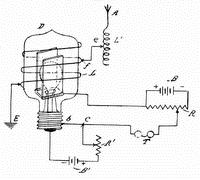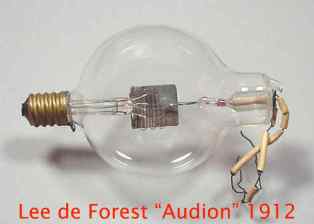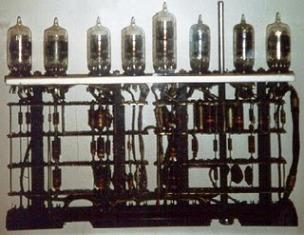Categories: Featured Articles » Interesting Facts
Number of views: 14085
Comments on the article: 1
Lee de Forest and the first steps of electronics
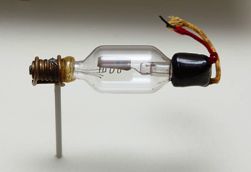 What nation would not like to call one of its sons the inventor of radio and list the priority of a great discovery behind their homeland? That is why disputes among the historians of science have not ceased for a century.
What nation would not like to call one of its sons the inventor of radio and list the priority of a great discovery behind their homeland? That is why disputes among the historians of science have not ceased for a century.
The most convincing arguments and opinions are presented, in which there are not so many names: Maxwell (England), Hertz (Germany), Branly (France), Popov (Russia), Marconi (Italy).
Among this galaxy of great minds, each of which deserves the honor of being included in the "biography" of a new means of communication, you can meet other scientists, "lower rank". But even among them, an American engineer Lee de Forest It seems that the figure, at first glance, is not quite suitable for the role of the founder of the radio. After all, he began research in the field of radio telegraphy, after the first signals were transmitted across the Atlantic, and the spark telegraph, as the radio was then called, was widely used in practice. But why, in the homeland of a scientist engineer, in the USA, is his name pronounced in combination with the words “father of radio” and even “grandfather of television”? Indeed, there must be good reason for this. And they are.
The radiotelephone is relevant
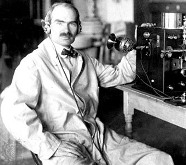 The end of the nineteenth century. was marked by an event that was initially given little importance. Assistants A. S. Popov - P. N. Rybkin and D. S. Troitsky discovered from the current point of view a "self-evident" thing.
The end of the nineteenth century. was marked by an event that was initially given little importance. Assistants A. S. Popov - P. N. Rybkin and D. S. Troitsky discovered from the current point of view a "self-evident" thing.
Trying to find a malfunction in the radio by the “ringing” of electric circuits using an ordinary telephone handset, they distinctly heard the radio signals from the Morse code of the nearest radio station.
Firstly, this meant that using radio waves you can transmit sound signals. Secondly, it became possible to receive a low-power signal by ear, to which the receiver relay did not respond - an indispensable element of the first designs.
On July 26, 1899, A. S. Popov received the Russian privilege and patents in England and France for “Telephone receiver of dispatches sent using electromagnetic waves via the Morse system” [2]. Tests of the new communication system, it was decided to conduct on the existing squadron of the Black Sea Fleet. During the 1901 summer campaign in the Novorossiysk region, the range of transmission at times reached 80 miles (about 150 km). Although the coverage area was slightly smaller, the conclusion that the radio waves are perceived beyond the horizon, was unambiguous [3].
The original version of the gas detector. It is appropriate to give a classic example of "stupidity" when the bureaucracy stands in the way of progress. “The command of the Black Sea Fleet,” Rybkin said, “banned the use of radiotelephones in the fleet, referring to the fact that the telegraph tape is a document, while trusting the radio operator who received the word was required to confirm with the official seal. And time passed, ahead were the tragedies of Tsushima and the Titanic, but there were no incentives for conducting research in the field of broadcasting human speech on the radio.
In the United States at that time, such work has already begun. Their results showed that spark transmitters are not suitable for this purpose and the frequency of the carrier wave should be at least 10 thousand periods per second.
Engineer R. Fesenden, who created high-frequency electric machine generators (alternators), took up the issues of radiotelephony. Since 1906, with their help, the first radiotelephone negotiations were held on the Atlantic coast. By the way, their topic was the cost of fish in the Boston market.
Navigators in the United States refused to study the rules of work by telegraph key, so it was decided to have radio operators only on passenger ships (other vessels were equipped only with a radiotelephone).
"Audio" - the so-called invention
Lee de Forest appears in the arena of spark telegraph work in 1900. Having replaced several laboratories of pioneers of a new type of communication, in 1902 he organized his own American Wireless Telegraph Company.
From electrical engineering, he knew that when the air was irradiated with the flame of a burning candle, it becomes conductive. The same thing happened when heating any rarefied gas. Confident that sooner or later, among the gases glowing under the influence of electric current, a good detector for Hertz waves can be found, Lee de Forest starts experiments.
Already in 1903 he made a very successful and promising experience. Two platinum plates of the air condenser “licked” the flame of the burner, and the field of the electromagnetic coil connected between the antenna and the ground acted on the plasma inside it (Fig. 1).
Fig. 1.
With this detector, Lee de Forest received signals from a ship in New York Harbor. The first success inspired the inventor. But to put such a device into practice was not possible. “It was obvious that a device with a gas flame was unacceptable for a ship radio station,” the inventor wrote, “so I began to look for a way to heat the gas directly with electric current.”
The easiest way to do this was to use an ordinary Edison light bulb, inserting platinum plates of electrodes there and wrapping a glass bulb of the lamp with part of the receiving coil. Subsequently, one of the platinum electrodes was removed, and instead of it a hot lamp thread was used (Fig. 2). A radio with such a detector worked no worse than other similar devices, but no better.
Fig. 2.
Conducting numerous experiments, Lee de Forest once wrapped a glass cylinder of a lamp with metal foil connected to an antenna. The receiver has become more sensitive. “At that moment,” the scientist recalls, “I realized that the efficiency of the lamp can be increased if the third electrode is placed inside.” What the experimenter hurried to do. The reception quality has increased.
Further experiments lead the inventor to the idea that it is effective if it is placed between the filament and the current collector plate. “Obviously,” says Lee de Forest, “that the third electrode should not be a solid plate.”
The search began for materials, shapes and sizes of the electrode, as well as its location between the two terminals of the bulb.
The most successful design was in which the role of one electrode was played by a red-hot filament of a bulb placed in another electrode in the form of a cylinder. Between them the third electrode was located, made in the form of a wire spiral (Fig. 3).
Fig. 3.
The inventor called his brainchild an "audion" (from the Latin "audio" - to hear and the Greek "ion" - going). The quality of the device was determined by the strength of the sound of the received signal by ear, and it exceeded all devices used before. Later, with a light hand of the English electrical engineer William Eccles, lamps with three electrodes were called triodes.
Fig. 4.
Search for truth and discovery
Naval radio operators (namely, the fleet used a new means of communication), trying to increase the sensitivity of the audions, heated the filament to unacceptable limits, and they burned out. The specialists of the Navy, without understanding the problem, gave the order "not to acquire audions, but to use old detectors."
Scientists did not find anything new in the design of Lee de Forest. Here is what Fleming, the inventor of the diode, wrote: “In October 1906, Dr. Forest described a device he called an audion, which is a simple repetition of mine, described eighteen months earlier. The introduced change does not give a significant difference in the actions of the device as a detector ”[6]. It was written in 1907, but even in 1908, the Frenchman C. Tissot confirms Fleming's priority.
An interesting fact is that both inventors of original electronic devices, which accepted the electron as reality, approached the determination of priority from different perspectives. Fleming considered the devices electronic, and Lee de Forest - ionic. However, there is nothing surprising in this.
The electrical circuit of a radio receiver with a gas detector The vacuum pumps existing at that time, intended for the production of electric bulbs, were so imperfect that it made it possible to interpret the processes occurring in the audion in two ways. Lee de Forest believed that his device works on the principle of ionization of a deeply rarefied gas. Only the invention of diffusion vacuum pumps and many years of research allowed us to thoroughly study the capabilities of a radio tube with an additional electrode and to verify the electronic nature of its internal processes.
Truly revolutionary was the ability of the audion to amplify the signal arriving at him. Radio receivers could now perceive signals from remote radio stations or very weak ones. Transmitter powers could be reduced, which contributed to the wider distribution of the radiotelephone.
However, the development of human speech transmission systems did not set themselves the task of introducing broadcasting, information, or music perics, but needed radiotelephony for business and beneficial two-way communication, but an unexpected thing happened ...
Everyone is tired of annoying radio and television advertising. But for the sake of historical justice, we must admit that radio advertising appeared before broadcasting. And the most directly related to it is none other than the inventor of the audion.
Here is what Lee de Forest himself wrote: “In 1909, I produced cordless telephones for the United States. Each kit was tested using phonograph notes. To my surprise, many hams and professional operators enjoyed these control programs. Naturally, the idea of broadcasting came to me. Attractive music and interesting programs could be broadcast, creating a demand for wireless equipment. ”
For advertising purposes, the first live broadcasts from the New York Metropolitan Opera were organized, and in November 1916 the idea of transferring the counting procedure during the presidential election was realized. It was she who sharply increased interest in broadcast radio broadcasts.
For the first time in the world, regular broadcasting began in the USA from the city of Pittsburgh since 1921. The first radio advertising, which described the advantages and low cost of apartments in the skyscrapers of Long Island, was broadcast in 1922 from New York. However, Lee de Forest had nothing to do with her.
Fig. 5.
Another discovery
Having successfully implemented his audio into a radio, Lee de Forest could not pass by the idea of using it in a radio transmitter. The fact is that the generation of radio waves is associated with devices that carry out oscillatory processes. There are many such emitters of vibrations in nature. This is a sounding bell, and vocal cords, and a chandelier swinging under the ceiling, and a pendulum of a wall clock.
In electricity, you can create a source of oscillation by combining a charged capacitor and inductance in a circuit, forming a so-called oscillatory circuit. All natural vibrational systems produce damped vibrations. The string ceases to sound after some time, the sea waves calm down. Fluctuations in the circuits also fade.
High-quality broadcasts require undamped oscillations. And this is not easy to do. For the long wavelength range, you can create a machine generator of high-frequency oscillations. But how to solve the problem with the oscillatory circuit, providing oscillations of almost any frequency?
For example, in a wall clock to create undamped oscillations of the pendulum for several days, special mechanisms were built in that regularly push the pendulum at a strictly defined moment in the phase of its movement. The energy for this is taken from the raised weights or wound spring. The device is called an anchor mechanism.
But what about the oscillatory circuit? Lee de Forest includes an oscillatory circuit in the circuit of his audion’s grid, and through the electric circuits the amplified signal from the oscillatory circuit again falls on the same circuit, “pushing” the oscillations at the right moment so that the amplitude and opening in electrical engineering are called positive feedback and are now used in thousands of different devices.
Lee de Forest received a patent for this system in 1915. Now, it was not difficult to obtain electrical oscillations of the required frequencies. True, the first tube generators at first could not provide the power needed for the transmitters. A fierce competition will begin between alternators and tube generators. In the end, the alternators will disappear from use, and the electronic lamp will take its rightful place.
But the inventor of the audion would not be an American if he had not found practical application for his device, not only on the radio. He creates the first electronic musical instrument.
Having constructed an electric generator of sound frequencies at audions, one triode per octave and amplifying the signals, he feeds them into loudspeakers located around the perimeter of the room. So along the way, surround sound issues are resolved. But, most importantly, by changing the setting of the oscillatory circuits, Lee de Forest managed to get enchanting sounds, unusual for the human ear.
Lee de Forest called his instrument “audio piano”. At the same time, prophetic words were expressed: “I hope that with the help of this small electronic lamp I can make the instrument perfect enough so that musicians can realize their richest musical fantasies.”
"The Great Mute" spoke
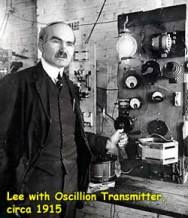 Cinema appeared almost simultaneously with the first radio receiver. The brothers Louis and Auguste Lumiere in March 1895 conducted a pilot demonstration of the first documented shots. By the end of that year, the first commercial movie theater was built in Paris. Initially, films could not even be considered as such, however, cinemas were referred to as “technical attractions” under the name “live photography”.
Cinema appeared almost simultaneously with the first radio receiver. The brothers Louis and Auguste Lumiere in March 1895 conducted a pilot demonstration of the first documented shots. By the end of that year, the first commercial movie theater was built in Paris. Initially, films could not even be considered as such, however, cinemas were referred to as “technical attractions” under the name “live photography”.
But very soon, these attractions became serious competitors to the ordinary theater. A new art form is emerging, cheaper and more mobile. Soon, the entire territory of the United States was covered by a network of cinemas, which were visited by up to 5 million viewers per day. It became clear that this is also a big business [7].
But how long can people be interested in, albeit artistic, but facial expressions and short subtitles? The appearance on the screens of prominent actors raised the prestige of new art to the title of "great dumb", but, as the English say, "a miracle is only nine days a miracle." The number of cinema visitors has begun to decline.
To improve the situation, they began to hire special musicians, tappers, who accompanied the movie show with music. The great A. Edison adapted his phonograph for this purpose.
A certain inventor, Homon, offered the venerable public a “chronophon”. A loud name hid an ordinary phonograph record, rotated synchronously with a film motor, where the lips of the actors more or less coincided with the sound. But the gramophone was standing near the movie screen, and the projector was at the other end of the hall. Managing such a system was difficult. About the sound quality turned out to be, as they say, out of work.
Electrical companies merged into conglomerates. Giant companies did not need him, and pride did not allow him to be content with the position of an ordinary engineer with a monthly salary. And Forest decided to tackle the problems of scoring films.
His idea was that the “light bunny” recorded on a photosensitive film the sound variations on the sound track parallel to the image. The synchronicity was perfect. With the help of audions it was possible to achieve any volume.
To advertise his new invention from 1923 to 1927, Lee de Forest shot more than 100 sound shorts with many famous actors, anticipating the appearance of modern video clips.
The inventor for advertising his “phonofilm” surprised compatriots by reproducing on the movie screen the speech of the 30th US President Coolidge on the lawn in front of the White House. For the first time, an American leader spoke from the screen. The audience this novelty delighted. The fever began again. Was born
The Golden Age of Hollywood.
But the inventor did not have to take advantage of this success. “The lawyers of Western Electric and Telephone Company,” wrote the biographer of Forest, M. Wilson, “successfully circled his finger and took advantage of his invention for free.”
A large and fruitful life was spent by the American engineer Lee de Forest. Humanity owes a lot to him. One of the first he believed in the existence of an electron, together with Fleming laid the foundations of radio electronics.
The results of his research have found application in many familiar things: from an ultra-modern mobile phone to a barcode on goods. However, despite numerous petitions, he was never awarded the Nobel Prize.
On October 5, 1956, 50 years after the invention of the radio tube (audion), the French government awarded Lee de Forest the Order of the Legion of Honor. At the presentation of the award, the words were said that "the discovery of Lee de Forest is one of the greatest in the history of science and technology, and experts in all fields of science should express their respect, their appreciation and their admiration." These words were spoken by the Nobel Prize laureate physicist Louis de Broglie, one of the founders of quantum physics. And he knew what he was saying.
See also at bgv.electricianexp.com
:


